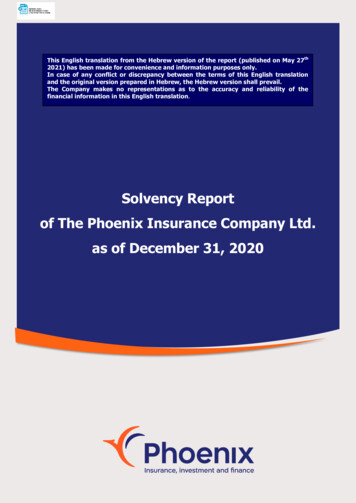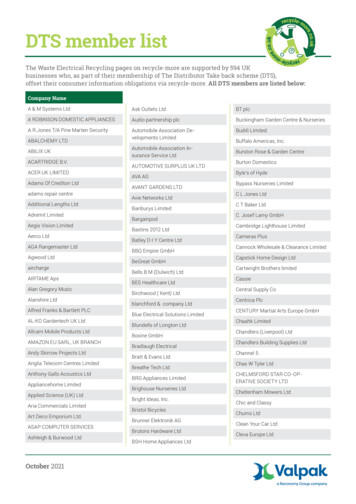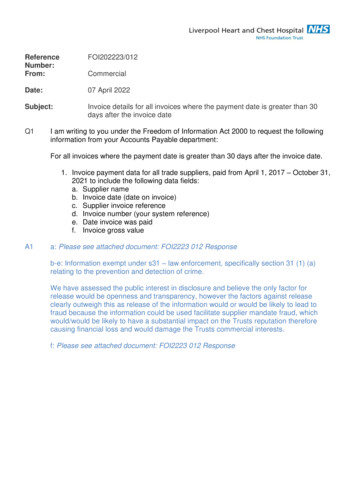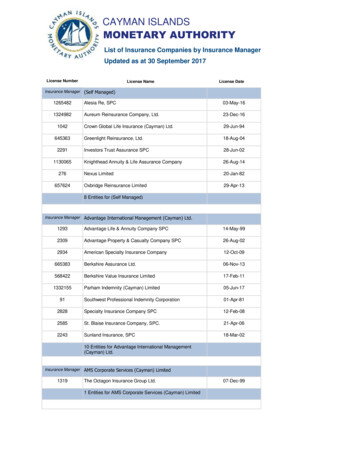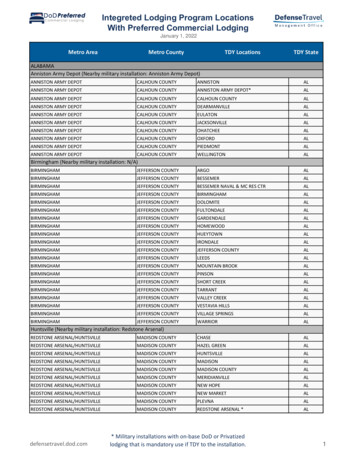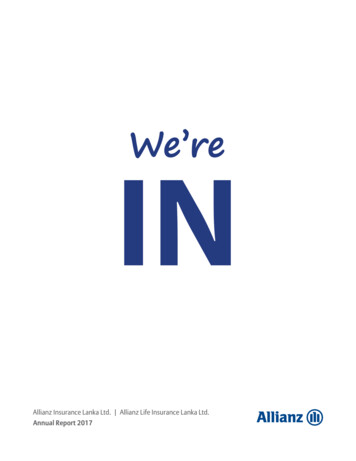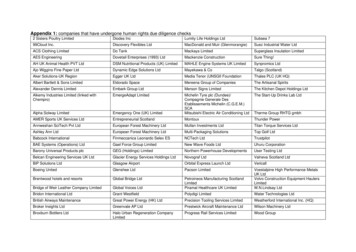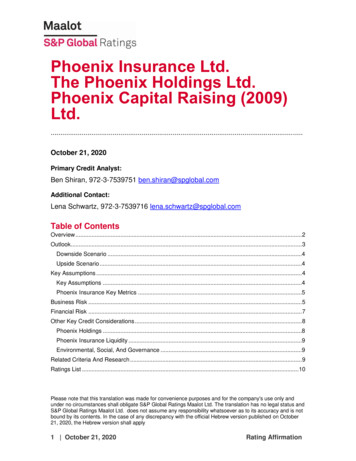
Transcription
Phoenix Insurance Ltd.The Phoenix Holdings Ltd.Phoenix Capital Raising (2009)Ltd.October 21, 2020Primary Credit Analyst:Ben Shiran, 972-3-7539751 ben.shiran@spglobal.comAdditional Contact:Lena Schwartz, 972-3-7539716 lena.schwartz@spglobal.comTable of ContentsOverview . 2Outlook. 3Downside Scenario .4Upside Scenario .4Key Assumptions . 4Key Assumptions .4Phoenix Insurance Key Metrics .5Business Risk . 5Financial Risk . 7Other Key Credit Considerations . 8Phoenix Holdings .8Phoenix Insurance Liquidity .9Environmental, Social, And Governance .9Related Criteria And Research . 9Ratings List . 10Please note that this translation was made for convenience purposes and for the company's use only andunder no circumstances shall obligate S&P Global Ratings Maalot Ltd. The translation has no legal status andS&P Global Ratings Maalot Ltd. does not assume any responsibility whatsoever as to its accuracy and is notbound by its contents. In the case of any discrepancy with the official Hebrew version published on October21, 2020, the Hebrew version shall apply1 October 21, 2020Rating Affirmation
Phoenix Insurance Ltd.The Phoenix Holdings Ltd.Phoenix Capital Raising (2009) Ltd.Phoenix Insurance Ltd.Issuer Credit AffirmedilAA /StableThe Phoenix Holdings Ltd.Issuer Credit AffirmedilAA-/StablePhoenix Capital Raising (2009) Ltd.OverviewKey StrengthsKey Risks Established business position as one of thethree largest insurance groups in Israel. Diversified income sources and distributionchannels.Low interest environment triggering profitvolatility due to frequent strengthening of lifeand health insurance reserves. Strong profitability compared with most localpeers, measured by an average ROE of 10%in the last five years.Capital market volatility which may triggervolatility in investment income and overallprofitability. Challenging economic condition and businessenvironment as a result of the coronaviruspandemic. Phoenix Insurance Ltd. (“Phoenix Insurance” or “the Company”) will continue to benefit fromits leading business position in the Israeli insurance industry and from its diversified businessmodel. As one of the three largest insurance companies in Israel, Phoenix Insurance holds a marketshare of 16% of total premiums as of December 31, 2019. We assume that in the next two years,Phoenix Insurance will continue diversifying its controlled distribution channels, in addition totraditional distribution activity through insurance agents. This trend is expected to support theCompany's efforts to continue strengthening its profitability and its business position in the industry.We expect Phoenix Insurance’s total premiums to decline, mainly in the health segment and onunit-linked life insurance policies. On the other hand, we expect growth in the group’s pensionfund and provident fund deposits. The expected decline in health insurance premiums will resultmainly from a decrease in travel insurance activity as a result of the coronavirus pandemic effects, andfrom the termination of the Meuhedet Health Fund’s long term care insurance contract followingPhoenix's win in the bid for Maccabi Health Fund’s contract. In the life insurance and long term2 ׀ October 21, 2020www.maalot.co.il
Phoenix Insurance Ltd.The Phoenix Holdings Ltd.Phoenix Capital Raising (2009) Ltd.savings segment, we expect pension and provident funds deposits to continue growing at the expenseof unit linked life insurance policies premiums, as a result of the regulatory change to unit-linked lifepolicies structure, which made them, in our view, a less attractive product.The Company will continue to benefit from its sound underwriting profitability in its PC lines inthe next two years. Our view is supported by Phoenix Insurance’s pricing strategy, which is positivelyaffected by its technological capabilities, advanced use of its databases, and their use in underwritingprocedures. Our view is also supported by the Company’s consistent focus on growth in moreprofitable lines, such as motor and property. These are the main contributors for the Company’s goodunderwriting profitability, as measured by a 91% average net combined ratio over the past five years.The Phoenix Holdings’ liquidity will remain sufficient, as well as its ability to serve its debtfrom its own resources. Our assessment is supported by Phoenix Holdings’ actions toincrease its business diversification. We believe cash flow streams from non-regulated entities, inparticular subsidiaries Phoenix Agencies and Excellence, will be sufficient to cover Phoenix Holdings’ongoing cash requirements. We believe Phoenix Holdings will focus on accelerated growth in theseactivities to further increase non-regulatory cash flows and decrease its dependence on dividendstreams from Phoenix Insurance.Phoenix's capitalization, both on group and standalone basis, reflects stability compared withits on balance sheet risks. The group’s capital assessment, according to S&P global ratings riskbased capital model, reflects its strong total profitability in recent years and our expectation that it willmaintain stable average profitability in 2020-2022.We acknowledge a high degree of uncertainty about the evolution of the coronavirus pandemic. Thecurrent consensus among health experts is that COVID-19 will remain a threat until a vaccine oreffective treatment becomes widely available, which could be around mid-2021. We are using thisassumption in assessing the economic and credit implications associated with the pandemic (see ourresearch on S&P Maalot website and on S&P Global Ratings) website. As the situation evolves, wewill update our assumptions and estimates accordingly.OutlookThe stable outlook on Phoenix Insurance reflects our assessment that its current capital buffers issufficient to contain the risk of volatility in its operating performance in the next 18-24 months, due tothe expected slowdown in premium accumulation as a result of the weakening business environment,severe market volatility and the low interest rate environment. We believe The Phoenix’s stablebusiness position as a leading insurance group in Israel will support its ability to weather the3 ׀ October 21, 2020www.maalot.co.il
Phoenix Insurance Ltd.The Phoenix Holdings Ltd.Phoenix Capital Raising (2009) Ltd.challenging conditions in the next 18-24 months. Our assessment is supported by Phoenix Insurance’sdiversified business model and by its good operating performance, which supported its capitalaccumulation in recent years.The stable outlook on Phoenix Holdings reflects our expectations that it will maintain an adequatelevel of liquid sources, at least at the current level of 1.2x of uses, which will allow it to serve itsliquidity needs at least in the next 18-24 months.Downside ScenarioWe may lower the rating on Phoenix Insurance in the next 18-24 months in case of a markeddeterioration in operating performance that would erode its capital buffer and jeopardize its lossabsorbing capacity, thus materially weakening its capitalization. We may also downgrade PhoenixInsurance if its gross premium accumulation materially decreases, beyond our expectations and fasterthan local peers, leading us to conclude that its business position in the Israeli market has weakened.We may downgrade the Phoenix Holdings in the next 18-24 months in case of a deterioration in itscapacity to serve its liquidity needs from its own sources. A negative rating action on PhoenixInsurance could also lead to a similar action on Phoenix Holdings.Upside ScenarioWe may raise our rating on Phoenix Insurance in the next 18-24 months if its gross insurancepremium accumulation pace remains similar to the period prior to the coronavirus outbreak and itsoperating performance remains sound such that its stand-alone and consolidated capitalization arestrengthened beyond our expectations, or if we estimate that its market position has materiallystrengthened compared with local peers. However, an upgrade would only be possible if, in addition toits capital management policy, Phoenix Insurance sets clear financial goals, e.g. target leverage and aclear dividend policy, that will provide us with more certainty regarding its prospective capital levels.An upgrade on Phoenix Holdings in unlikely in the next 18-24 months.Key AssumptionsKey Assumptions A 5.5% contraction in real GDP in Israel in 2020 due to the coronavirus pandemic, and recoveryin 2021 with 6.5% growth. A 0.3% increase in CPI in 2021. An increase in the unemployment rate to about 9.5% in 2020 due to the coronavirus crisis, and adecrease to about 6% in 2021.4 ׀ October 21, 2020www.maalot.co.il
Phoenix Insurance Ltd.The Phoenix Holdings Ltd.Phoenix Capital Raising (2009) Ltd.Phoenix Insurance Key MetricsFinancial Metric20162017201820192020FGross premiums (Mil.NIS)8,9229,82610,13611,382 10,500Net Income (Mil. NIS)42055854727 300Return on Equity14.08%15.11%11.62%0.6% 5.7%Net combined ratio99.4%91.2%88.2%84.9% 88%F - forecastBusiness RiskPhoenix Insurance is one of the three largest insurance groups in Israel, and has an establishedbusiness position, with a market share of about 16% of total premiums in the Israeli insuranceindustry. Its total gross earned premiums in 2019 was NIS 11.3 billion. About 45% of its gross earnedpremiums were generated by its life insurance activity, while its health and PC Insurance operationsgenerated 28% and 25%, respectively. Over the past five years Phoenix Insurance’s average premiumgrowth was materially faster than local peers, about 8% per year compared with about 2% in theindustry as a whole.However, the challenging economic environment due to the coronavirus pandemic is expected todecelerate premium growth for Phoenix Insurance and its local peers in 2020. In addition, theregulatory changes to unit-linked life insurance policies, which cancel the built-in insurance componentin the policies, are expected to make them a less attractive product and lead to an increase in pensionand provident funds deposit at their expense. We believe that, in accordance with industry trends inrecent years, most of the Phoenix group’s marketing efforts in the long-term savings segment will gotowards pension funds, provident funds and financial savings, and towards achieving significant AUM(assets under management) growth which is crucial for the segment’s profitability in the medium- tolong term, especially as Phoenix’s pension AUM are low compared with local peers, that is to say,fixed management fees will have to balance out volatility in variable management fee revenue and theexpected decrease in unit-linked life insurance policies mentioned above.We believe Phoenix Insurance benefits from sound distribution capabilities in direct channels,especially in PC Insurance and particularly in vehicle insurance through the Phoenix Smart brandsuccessfully developed in recent years. We also estimate that Phoenix Agencies Ltd., fully controlled5 ׀ October 21, 2020www.maalot.co.il
Phoenix Insurance Ltd.The Phoenix Holdings Ltd.Phoenix Capital Raising (2009) Ltd.by Phoenix Holdings, provides additional distribution benefits to Phoenix Insurance. The Company’sability to maintain direct distribution activity alongside investment in service and digital tools it providesto insurance agents working with Phoenix, may support its business activity and operatingperformance in changing market condition and increasing competition. In addition, we believe thegroup’s cost saving actions through the pandemic, decreasing manpower by the end of 2020, will drivea decrease in expenses of about NIS 150 million per year, accelerate streamlining processes andincrease use of technological and digital operating tools.Chart 1: Return on Equity - Phoenix Insurance and Local 91%Average0%Phoenix’s good operating performance were reflected in high return on equity compared with theindustry in the past five years, about 10% per year compared with an average of about 8% for localpeers (see Chart 1). We believe Phoenix’s high profitability compared with local peers ispredominantly supported by high profitability in PC insurance, as measured by a net combined ratio(the ratio between total insurance claims and expenses to premiums - the lower this ratio, the higherunderwriting profitability is) of 92% on average over the past five years, low compared with its localpeers (see Chart 2). Phoenix’s good underwriting profitability compared with the industry is positivelyaffected by its technological capabilities, advanced use of its databases, and their use in underwritingprocedures, together with its focus on car and property lines. In addition, the liability segment, which ischaracterized by high underwriting losses, constitutes a smaller share of Phoenix’s PC insurancecompared with local peers. Phoenix Insurance’s high profitability is also positively affected by itsinvestment income.6 ׀ October 21, 2020www.maalot.co.il
Phoenix Insurance Ltd.The Phoenix Holdings Ltd.Phoenix Capital Raising (2009) Ltd.Chart 2: PC Insurance Net Combined 20182019PhoenixFinancial RiskThe coronavirus pandemic outbreak led to sharp drops in global capital markets in March 2020, whichled to significant investment losses for Phoenix Insurance and its local peers in the first quarter. OnMarch 31, 2020, Phoenix Insurance’s pre-tax investment losses totaled about NIS 945 million.However, markets recovered since, and as of June 30, 2020, the Company had a NIS 65 millioninvestment income. Despite the recovery, our capital and earnings forecast considers that capitalmarkets are expected to remain volatile at least in the next 12 months. We believe Phoenix Insuranceis weathering the challenging business environment from a relatively strong position. As of December31, 2019, the Company’s capital buffer over capital requirements as measured by our capital modelallows it to absorb the volatility we expect to see in capital markets.In our base case scenario we assume a 5%-8% decrease in Phoenix Insurance’s premiums in 2020,rebounding to 2%-3% growth per year in 2021-2022. Our assessment is based on the expected GDPcontraction in 2020, higher unemployment and weakened economic environment, alongside regulatorychanges in the structure of unit-linked life insurance policies. We expect the life insurance and longterm savings segment to post the strongest decline, due to its sensitivity to labor market shifts and tothe unemployment rate. Also, in addition to the effects of the coronavirus pandemic on travelinsurance, health insurance premiums are likely to decrease in 2020 due to the termination of theCompany’s engagement with Meuhedet Health Fund on its long term care insurance plan. We alsoexpect a decrease in average AUM in 2020, and consequently a decrease in management feecollection. Low or no collection of variable management fees due to capital market volatility is alsoexpected to adversely affect total management fee revenue. We expect Phoenix Insurance’s strong7 ׀ October 21, 2020www.maalot.co.il
Phoenix Insurance Ltd.The Phoenix Holdings Ltd.Phoenix Capital Raising (2009) Ltd.underwriting profitability in the PC lines to remain stable, with a net combined ratio of about 91% onaverage in 2020-2022. Also, excluding health LAT (liability adequacy test) reserves release, we expecthealth insurance underwriting profitability to hover around 100% in the outlook horizon.Phoenix group’s capital assessment, according to S&P Global Ratings’ risk based capital model,reflects its strong total profitability in recent years, which is positively affected mainly by PhoenixInsurance’s high profitability and is reflected both in Phoenix Insurance’s capitalization and in thegroup’s consolidated capitalization. At the same time, changes in the group’s organizational structure,including placement of “AD-120” under Phoenix Insurance and placing Phoenix Agencies underPhoenix Holdings, strengthened Phoenix Insurance’s capital. We therefore expect the currentcapitalization and adequate capital reserves to support the Company’s current rating in the next twoyears.Phoenix Insurance’s solvency ratio as of June 30, 2019, was 110% assuming full Solvency 2implementation, compared with 134% at year-end 2018. The decline in the solvency ratio mainlyreflects the effects of the decline in the risk-free yield curve on solvency requirements in life and longterm care insurance. We believe the approval of the amendments to the Solvency 2 circular, mainlythose related to spreading the capital requirements for long term life insurance reserves over 16 years,is expected to positively impact Phoenix Insurance’s solvency ratio. According to the publishedcircular, changes are expected to be reflected in the 2019 solvency report which is due to bepublished by the end of 2020. We expect the Company’s solvency ratio after the suggestedamendment to be materially above 100% considering transitional requirements. In addition, without aclear dividend policy, future capitalization level is uncertain.Our view of Phoenix insurance investment portfolio assets quality is largely driven by its about 46%exposure to Israeli government bonds rated 'AA-'. We also consider the leverage based on Phoenixgroup’s consolidated debt to remain below 45% in 2020-2022 (excluding the value in forcecomponent, which we do not count as part of on-balance capital). We also expect the average interestcoverage ratio to be materially higher than 4x in the same period.Other Key Credit ConsiderationsPhoenix HoldingsOur rating on Phoenix Holdings (ilAA-/Stable) reflects our view of its capability to serve its ongoingcash requirements. Our assessment is supported by Phoenix Holdings’ actions to increasediversification of the group’s activity, such as expanding Phoenix Agency’s operations by acquiringinsurance agencies. Our assessment takes into account dividend streams from non-regulated entities,8 ׀ October 21, 2020www.maalot.co.il
Phoenix Insurance Ltd.The Phoenix Holdings Ltd.Phoenix Capital Raising (2009) Ltd.in particular subsidiaries Phoenix Agencies and Excellence, and Phoenix Holdings’ ongoing cashrequirements, including management expenses and principal and interest payments on issued bonds.This assessment reflects a sources to uses ratio of at least 1.2x on an annual basis in the next 18-24months. Our assessment is also supported by the fact that Phoenix Holdings has sufficient liquid assetcompared with its cash requirements (at least 1.5x on an annual basis in the next 18-24 months).Phoenix Insurance LiquidityWe assess Phoenix Insurance’s liquidity as ‘adequate’. The Company has large cash and liquidinvestment reserves compared with its on-balance obligation.Environmental, Social, And GovernancePhoenix group’s corporate governance is in line with local insurance industry norms. We believe thegroup’s management has been implementing its strategic plans successfully in recent years. We alsobelieve the Company has a clear view of the risk inherent in its business operation, as reflected in itsrisk management and capital management policies and the tools it’s developing.As an insurance company operating in the life and health insurance lines, its exposure toenvironmental and social factors may lead to an increase in its obligation, for instance as a result ofhigher life expectancy and an increase in chronic morbidity due to lifestyle changes. In PC insurance,we estimate the Company’s exposure to climate damages as limited, due to the fact that it onlyoperates in Israel. However, in recent years we have seen climate changes causing harsher weatherconditions in Israel in the winter, mainly floods. The Company is fully covered against this kind ofcatastrophic risks through re-insurance.Related Criteria And Research Refined Methodology And Assumptions For Analyzing Insurer Capital Adequacy Using The RiskBased Insurance Capital Model, June 7, 2010 Principles Of Credit Ratings, February 16, 2011 Methodology For National And Regional Scale Credit Ratings, June 25, 2018 Hybrid Capital: Methodology And Assumptions, July 1, 2019 Insurers Rating Methodology, July 1, 2019 Group Rating Methodology, July 1, 2019 S&P Global Ratings Definitions, August 7, 20209 ׀ October 21, 2020www.maalot.co.il
Phoenix Insurance Ltd.The Phoenix Holdings Ltd.Phoenix Capital Raising (2009) Ltd.Ratings ListAdditional detailsPhoenix Insurance Ltd.Issuer rating(s)Long termilAA /StableIssuer Credit Rating historyLong termApril 21, 2020October 07, 2018February 19, 2017November 13, 2015May 19 ,2014November 18, 2012July 17, 2012October 11, 2011August 25, 2010August 17, 2009May 19 ,2009February 08, 2009May 24 ,2004ilAA /StableilAA /PositiveilAA /StableilAA /NegativeilAA /StableilAA /NegativeilAA /Watch NegilAA /StableilAA/StableilAA-/NegativeilAA-/Watch NegilAA/Watch NegilAAThe Phoenix Holdings Ltd.Issuer rating(s)Long termilAA-/StableIssue rating(s)Senior Unsecured DebtSeries 3,4,5ilAA-Issuer Credit Rating historyLong termOctober 06, 2019October 07, 2018February 19, 2017November 13, 2015May 19 ,2014November 18, 2012July 17, 2012January 12, 2012August 25, 2010May 19 ,2009November 16, 2008May 14 ,2007ilAA-/StableilA /PositiveilA /StableilA /NegativeilA /StableilA /NegativeilA /Watch NegilA /StableilA/StableilA/NegativeilAA/Watch NegilAA/Stable10 ׀ October 21, 2020www.maalot.co.il
Phoenix Insurance Ltd.The Phoenix Holdings Ltd.Phoenix Capital Raising (2009) Ltd.Additional details - continuedPhoenix Capital Raising (2009) Ltd.Issue rating(s)Subordinate hybrid debtSeries D, E, F, G, H, I, JilAA-Additional detailsTime of the eventTime when the event was learned ofRating requested by21/10/2020 14:2621/10/2020 14:26Issuer11 ׀ October 21, 2020www.maalot.co.il
Phoenix Insurance Ltd.The Phoenix Holdings Ltd.Phoenix Capital Raising (2009) Ltd.S&P Maalot is the commercial name of S&P Global Ratings Maalot Ltd. For a list of the most up-to-date ratingsand for additional information regarding S&P Maalot’s surveillance policy, see S&P Global Ratings Maalot Ltd.website at www.maalot.co.il.All rights reserved No content (including ratings, credit-related analyses and data, valuations, model, softwareor other application or output therefrom) or any part thereof (collectively, “the Content”) may be modified, reverseengineered, reproduced or distributed in any form by any means, or stored in a database or retrieval system,without the prior written permission of of S&P Global Ratings Maalot Ltd. or its affiliates (collectively, S&P). TheContent shall not be used for any unlawful or unauthorized purposes. &P and any third-party providers, as wellas their directors, officers, shareholders, employees or agents (collectively, “S&P Parties”) do not guarantee theaccuracy, completeness, timeliness or availability of the Content. S&P Parties are not responsible for any errorsor omissions (negligent or otherwise), regardless of the cause, for the results obtained from the use of theContent, or for the security or maintenance of any data input by the user. The Content is provided on an "as is"basis. S&P PARTIES DISCLAIM ANY AND ALL EXPRESS OR IMPLIED WARRANTIES, INCLUDING, BUTNOT LIMITED TO, ANY WARRANTIES OF MERCHANTABILITY OR FITNESS FOR A PARTICULARPURPOSE OR USE, FREEDOM FROM BUGS, SOFTWARE ERRORS OR DEFECTS, THAT THECONTENT’S FUNCTIONING WILL BE UNINTERRUPTED OR THAT THE CONTENT WILL OPERATE WITHANY SOFTWARE OR HARDWARE CONFIGURATION. In no event shall S&P Parties be liable to any party forany direct, indirect, incidental, exemplary, compensatory, punitive, special or consequential damages, costs,expenses, legal fees, or losses (including, without limitation, lost income or lost profits and opportunity costs orlosses caused by negligence) in connection with any use of the Content even if advised of the possibility of suchdamages.Credit-related and other analyses, including ratings, and statements in the Content are statements of opinion asof the date they are expressed and not statements of fact. S&P’s ratings and other analyses are notrecommendations to purchase, hold, or sell any securities or to make any investment decisions, and do notaddress the suitability of any security. S&P assumes no obligation to update the Content following publication inany form or format. The Content should not be relied on in making investment decisions or any other businessdecision, and is not a substitute for the skill, judgment and experience of the user, its management, employees,advisors and/or clients when making such decisions. S&P does not act as a fiduciary or an investment advisorexcept where registered as such. Rating reports are correct as of the time of their publication. S&P updatesrating reports following ongoing surveillance of events or annual surveillance.While S&P obtains information from sources it believes to be reliable, S&P does not perform an audit andundertakes no duty of due diligence or independent verification of any information it receives. S&P publishesrating-related reports for a variety of reasons that are not necessarily dependent on action by rating committees,including, but not limited to, the publication of a periodic update on a credit rating and related analyses.To the extent that regulatory authorities allow a rating agency to acknowledge in one jurisdiction a rating issuedin another jurisdiction for certain regulatory purposes, S&P reserves the right to assign, withdraw or suspendsuch acknowledgment at any time and in its sole discretion. S&P Parties disclaim any duty whatsoever arisingout of the assignment, withdrawal or suspension of an acknowledgment as well as any liability for any damagealleged to have been suffered on account thereof.S&P keeps certain activities of its business units separate from each other in order to preserve theindependence and objectivity of their respective activities. S&P has established policies and procedures tomaintain the confidentiality of certain non-public information received in connection with each analytical process.S&P receives compensation for its ratings and certain analyses, normally from issuers or underwriters ofsecurities or from obligors. S&P reserves the right to disseminate its opinions and analyses. S&P's public ratingsand analyses are made available on S&P Maalot’s website, www.maalot.co.il and on S&P Global’s website,www.standardandpoors.com, and may be distributed through other means, including via S&P publications andthird-party redistributors.12 ׀ October 21, 2020www.maalot.co.il
As one of the three largest insurance companies in Israel, Phoenix Insurance holds a market share of 16% of total premiums as of December 31, 2019. We assume that in the next two years, Phoenix Insurance will continue diversifying its controlled distribution channels, in addition to traditional distribution activity through insurance agents.


